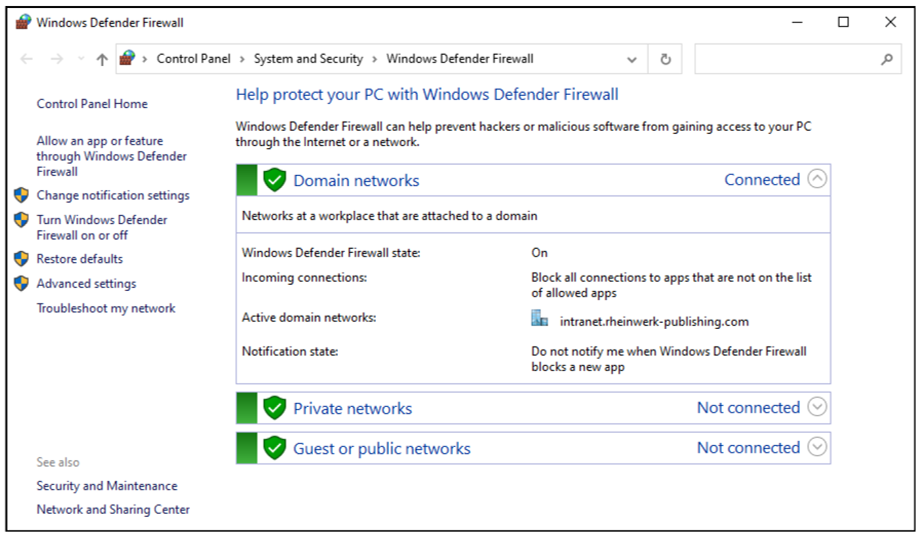

Cybersecurity is about protecting digital assets from threats through physical safeguards, encryption, application security, network defenses, and strong policies. Core tools include firewalls, VPNs, intrusion detection systems, and SIEM. Best practices like zero trust, data masking, backups, and employee training ensure resilience.
Hardware and physical security is the bedrock of a robust cybersecurity strategy. This involves safeguarding the physical components of computing systems from unauthorized access and manipulation. Measures include the following.
Access controls refer to security measures that regulate who or what can view or use resources in a computing environment. This includes user authentication, authorization, and permissions.
Secure boot is a security standard developed to ensure that a device boots using only software that is trusted by the device manufacturer. It prevents the loading of unauthorized or tampered operating systems. By enabling secure boot, administrators ensure that only authorized and digitally signed software is allowed to run during the system startup process.
Employing hardware-based encryption modules allows you to protect sensitive data stored on devices, rendering it unreadable without proper authentication.
Cybersecurity is a broad domain that addresses the protection of computer systems, networks, and data from cyber threats. Key components include the following.
Firewalls are network security devices that monitor and control incoming and outgoing network traffic based on predetermined security rules. They act as a barrier between a secure internal network and untrusted external networks, such as the internet.

Intrusion detection systems (IDS) and intrusion prevention systems (IPS) monitor network traffic for suspicious activity and taking proactive measures to prevent potential threats. IDS monitors network or system activities for malicious exploits or security policy violations. IPS takes it a step further by automatically responding to detected threats, preventing them from reaching the target.
Antivirus Software
Antivirus software is designed to detect, prevent, and remove malicious software (malware) from computer systems. It includes features such as real-time scanning and heuristic analysis to identify and mitigate threats.
Incident Response Planning
Incident response planning involved developing and implementing strategies to respond effectively to security incidents, minimizing potential damage and downtime.
Encryption is pivotal for protecting sensitive data by converting it into a coded format that is unreadable without the appropriate decryption key. Key elements of encryption include the following.
Symmetric Encryption
Symmetric encryption is a type of encryption where the same key is used for both the encryption and decryption of data. It is fast and efficient for large amounts of data but requires a secure method for key exchange.
Asymmetric Encryption
Asymmetric encryption, or public-key cryptography, uses a pair of public and private keys for secure communication. The public key is used for encryption, while the private key is used for decryption. It enhances confidentiality and authentication.
Transport Layer Security
Transport layer security (TLS) is a cryptographic protocol designed to secure communication over a computer network. It is widely used to ensure the security of data transmitted between web browsers and servers, offering privacy and data integrity.
Data security involves protecting digital information from unauthorized access, disclosure, alteration, and destruction. Essential components include the following.
Access Controls
In the realm of data security, role-based access controls limit data access based on user roles and responsibilities. Identity and access management (IAM) is an area crucial for managing and controlling user access to systems and applications. This includes the following areas: single sign-on, which allows users to log in once and access multiple systems without repeated logins; and multi-factor authentication, which adds an extra layer of security by requiring multiple forms of identification before granting system access.
Data Backup and Recovery
To ensure that data isn’t lost in the event of a power loss or other emergency, it’s important to back up critical data and establish effective recovery mechanisms to mitigate the impact of data loss.
Data Masking and Anonymization
To make sure data isn’t viewable by unauthorized users, it’s a best practice to conceal sensitive information during testing or analysis, minimizing the risk of unauthorized exposure.
Application security (also known as AppSec) focuses on securing software and applications from vulnerabilities and exploits. Key considerations include the following.
Secure Coding Practices
It’s important to adhere to coding standards and best practices to eliminate common vulnerabilities, such as buffer overflows and injection attacks.
Authentication and Authorization
Robust authentication mechanisms can be used to verify user identity and define authorization rules to control access to application resources.
Regular Security Audits
Thorough security audits should be conducted to identify and address vulnerabilities in the application code and design.
Penetration Testing and Vulnerability Scanning
Beyond code reviews and audits, penetration testing simulates real-world attacks to uncover vulnerabilities before malicious actors exploit them. Automated vulnerability scanners complement this by continuously probing systems and applications for known weaknesses, ensuring faster remediation cycles.
Network security focuses on safeguarding communication pathways and infrastructure. Key components include the following.
Virtual Private Networks
Virtual private networks (VPNs) establish secure and encrypted connections over public networks to protect data during transmission.
Intrusion Prevention and Detection Systems
The use of intrusion prevention and detection systems allow administrators to continuously monitor network traffic for signs of unauthorized access or suspicious activities.
Network Segmentation
By dividing a network into segments, you can contain and mitigate the impact of security breaches.
Internet of Things Security
With the proliferation of connected devices, securing the Internet of Things (IoT) is paramount. Administrators need to ensure that IoT devices are only accessible to authorized entities, and that the communication between IoT devices and the central system is encrypted.
Cloud Security
Securing cloud environments requires a different approach than on-premise systems. In the cloud, providers are responsible for infrastructure security, while customers are responsible for securing data, configurations, and user access. This is known as the shared responsibility model. Tools such as cloud access security brokers (CASBs) provide monitoring, visibility, and enforcement between cloud providers and client systems.
Mobile Device Security (MDM, BYOD)
With many organizations allowing employees to use personal devices (bring your own device, or BYOD), mobile device security has become critical. Mobile device management (MDM) policies help enforce security baselines, such as remote wipe, encryption, and application control, reducing the risk of data loss or leakage from smartphones and tablets.
Developing and implementing comprehensive security policies and procedures is fundamental. This is because, no matter how robust a security system is in the backend, if the users utilizing the system don’t take caution, breaches can be possible through human error.
One way that companies can reduce the risk of a breach is through the zero trust model. This is a security concept and approach that challenges the traditional notion of trusting entities inside a network while being cautious about those outside it. In a zero trust framework, no user, system, or network is inherently trusted by default, regardless of their location—whether inside or outside the corporate firewall. Administrators can set up micro-segmentation, which involves implementing granular access controls to limit lateral movement within a network. They can also set up continuous authentication, which verifies user identities continuously rather than relying solely on initial login credentials.
To ensure employees are educated on security best practices, threats, and how to respond to incidents, they should be required to complete security awareness training. Users should be taught the basics of social engineering attacks like phishing attempts designed to collect user credentials.
Those who are responsible for the system administration should also undergo incident response planning, where procedures are outlined to effectively respond to and recover from security incidents. By utilizing the tools of security information and event management (SIEM), administrators can get a real-time analysis of security alerts generated by various hardware and applications. This helps them respond to security incidents promptly.
For companies that work with extra sensitive data, they should be aware of regulatory laws such as the General Data Protection Regulation (GDPR) and Health Insurance Portability and Accountability Act (HIPAA).
To ensure legal compliance for less sensitive data, companies need to develop and maintain clear privacy policies to inform users about data collection and usage practices.
Modern cybersecurity increasingly leverages artificial intelligence (AI) and machine learning to identify anomalies in real time. AI-driven systems can detect unusual user behavior, recognize new malware strains, and prioritize threats faster than manual monitoring alone.
Lastly, since the world of cybersecurity is ever-changing, it’s important to stay on top of what’s new in the world of malware and hacking.
Here are answers to some of the most common things people ask about cybersecurity.
Q: What is the difference between symmetric and asymmetric encryption?
A: Symmetric uses one key for both encryption and decryption; asymmetric uses a public/private key pair.
Q: What is zero trust in cybersecurity?
A: A security model that assumes no user or device is inherently trustworthy, requiring continuous authentication and strict access controls.
Q: Why is incident response planning important?
A: It ensures organizations can detect, contain, and recover from security breaches quickly, minimizing downtime and damage.
Q: What role do firewalls and IDS/IPS play in cybersecurity?
A: Firewalls block unauthorized traffic, while intrusion detection/prevention systems monitor for suspicious behavior and act against threats in real time.
Q: How does cybersecurity apply to IoT devices?
A: IoT security ensures connected devices are protected from unauthorized access and that their data is encrypted to prevent misuse.
Q: What is the difference between cybersecurity and information security?
A: Cybersecurity focuses on protecting digital systems and networks from attacks, while information security is broader, covering both digital and physical protection of data.
Q: Why is multi-factor authentication important?
A: MFA adds an extra layer of protection beyond passwords, reducing the chance of unauthorized access even if credentials are stolen.
Q: What is the shared responsibility model in cloud cybersecurity?
A: In cloud environments, providers secure the infrastructure, while customers are responsible for securing data, access, and usage within the cloud.
Q: What is the role of a Data Privacy Officer (DPO) in cybersecurity?
A: A DPO ensures compliance with privacy regulations (e.g., GDPR) and oversees how sensitive data is handled, especially in enterprise systems.
Q: What are CIS Benchmarks in cybersecurity?
A: They are best-practice configuration standards for securing systems against common threats.
In addition to the information laid out above, there are a handful of important terms you should also know:
Want to learn more about cybersecurity? Additional information can be found in the blog posts and books listed below.
Learn more computing from our official Learning Center.
And to continue learning even more about cybersecurity, sign up for our weekly blog recap here: